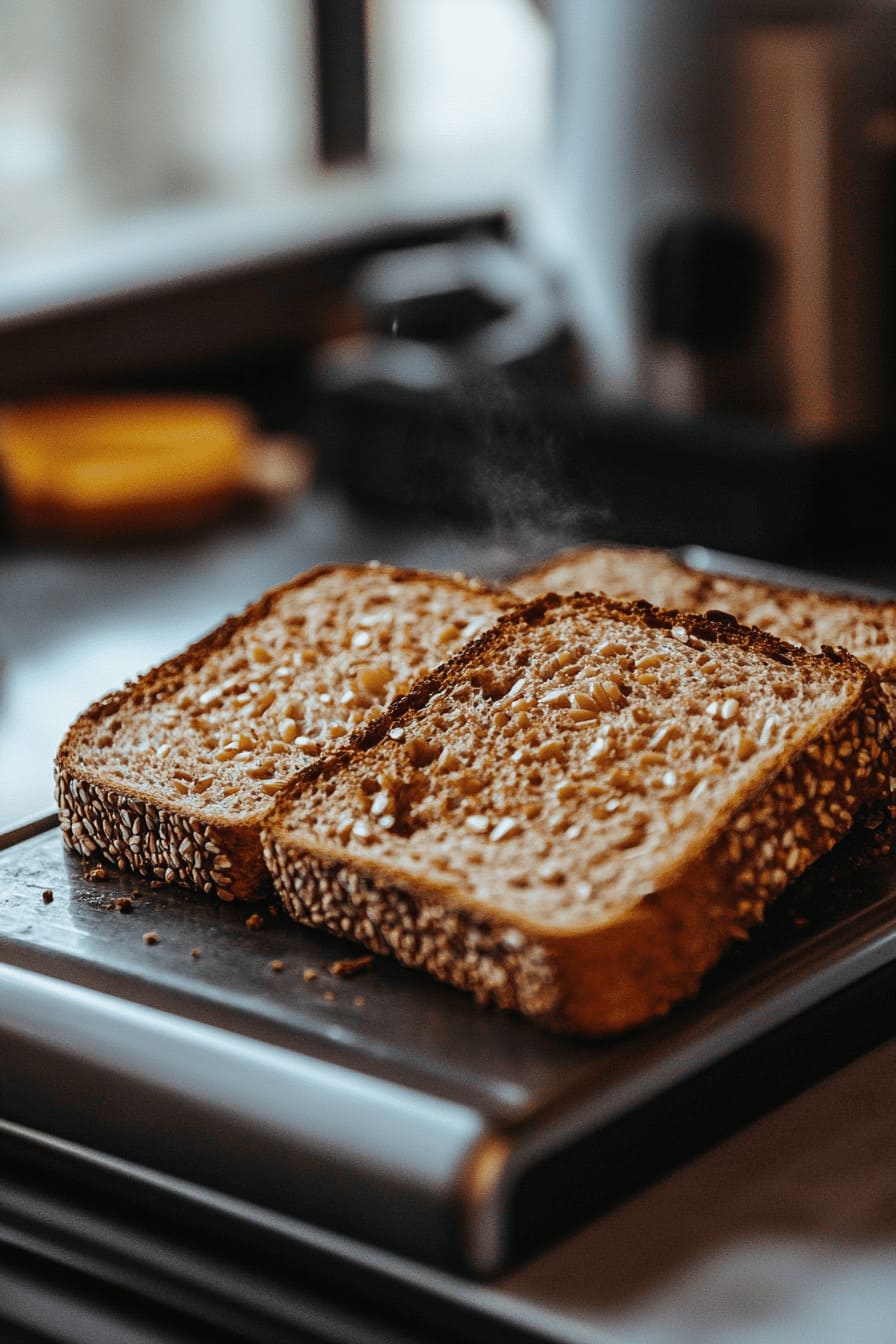Cheese-Filled Tomato and Avocado Omelette with Wholegrain Toasts
This post may contain affiliate links. That means if you click and buy, I may receive a small commission (at zero cost to you). Please see my full disclosure policy for more details.
Steal my Cheesy Tomato and Avocado Omelette with Wholegrain Toasts for your perfect gestational diabetes breakfast recipe.
The combination of creamy avocado and cheesy omelette is chef’s kiss!

This dish is a delicious twist on the classic avocado egg toast.
I wanted to shake things up by adding tomato and cheese, making it into a hearty omelette instead.
Personally, I prefer omelettes to runny eggs. And this gestational diabetes breakfast recipe delivers the perfect mix of creamy avocado, melty cheese, and the sweetness of tomatoes.
You may be interested: 25 Easy Breakfast Recipes for Gestational Diabetes
Why is This Avocado Omelette GDM-Friendly?
Kickstart your day with a breakfast that’s as tasty as it is good for you!
- Eggs: (GI = 0) Provide a savory flavor and fluffy texture, while being high in protein, which slows digestion. Egg helps prevent blood sugar spikes by lowering the meal’s glycemic load.
- Shredded cheese: (GI = 0) Adds a creamy, melty texture and savory taste. Come with fats and protein that slow carbohydrate absorption.
- Avocado: (GI = 40) Offers a smooth, buttery texture and mild flavor. Rich with monounsaturated fats and fiber that improve insulin sensitivity and slow the release of glucose.
- Tomato: (GI = 15) Adds a slight tang and juicy texture. Low in carbs and packed with antioxidants like lycopene and vitamin C, which aid in supporting insulin function.
- Wholegrain toast: (GI = 51 – 69) Has a hearty texture and nutty flavor. It provides complex carbs and fiber for slower digestion and a gradual rise in blood sugar.
- Olive oil: (GI = 0) Enhances flavor with a light, fruity richness. Olive oil adds monounsaturated fats that slow digestion and help maintain steady blood sugar levels.
Learn more: List of Glycemic Index of Over 650 Foods
Practical Tips to Reduce Sugar Spike
- Choose high-fiber wholegrain bread: Look for bread with at least 3-5 grams of fiber per slice, as this helps slow down carbohydrate absorption (more details in the FAQ section below).
- Control portion sizes: Stick to one or two slices of wholegrain toast, depending on your carbohydrate allowance, to maintain balanced blood sugar levels. The American Diabetes Association recommends 30-45g of carbohydrates per meal for gestational diabetes, with each slice of wholegrain toast containing about 10-15g of carbs.
- Pair with a side of non-starchy vegetables: Adding a small side of sautéed spinach, kale, or a mixed green salad can increase fiber intake and reduce post-meal sugar spike by up to 30%.
- Avoid added sugars: Ensure that any spreads or toppings for the toast (like butter or jam) do not contain added sugars that can spike blood sugar levels.
- Add spices and herbs: Enhance flavor with spices like black pepper, paprika, or herbs like parsley or cilantro instead of sauces that may contain sugar.
- Take a light 30-minute walk: Walking after meals can help lower blood sugar levels (by up to 20%) and improve glucose management.
Ingredients
- Eggs: 2 large
- Shredded cheese: ¼ cup (cheddar or mozzarella)
- Avocado: ¼, sliced
- Tomato: ¼ cup, diced
- Wholegrain toast: 2 slices
- Olive oil: 1 tsp (for cooking)
- Salt and pepper: to taste
Instructions
You don’t need to be a pro chef to whip this up.
1. Whisk the eggs: Whisk 2 large eggs in a small bowl until the yolks and whites are fully combined. Set aside.

2. Dice the tomato: Dice ½ a medium-sized tomato into small pieces, removing excess seeds and liquid by gently pressing the diced pieces with a paper towel to prevent the omelette from becoming watery.
3. Heat the skillet: Heat a non-stick skillet over medium heat for about 1 minute. Lightly spray the pan with olive oil to coat the surface.
4. Cook the eggs: Pour the whisked eggs into the heated skillet, tilting the pan to ensure the eggs spread evenly. Let the eggs cook undisturbed for 1-2 minutes until the edges start to firm up.
5. Add the filling: Evenly sprinkle the diced tomato and ¼ cup of shredded cheddar cheese across the surface of the partially cooked eggs. Ensure the filling is spread out so every bite has a balanced flavor.
6. Fold the omelette: Once the eggs are mostly set, carefully fold the omelette in half using a spatula. Allow it to cook for another 1-2 minutes, giving the cheese enough time to melt and ensuring the eggs are fully cooked through. I love to also add a few thin slices of tomato on top for some redness.

7. Toast the bread: While the omelette is cooking, place 2 slices of wholegrain bread into a toaster or onto a heated pan. Toast to your desired level of crispness, typically around 2-3 minutes.
8. Slice the avocado: Slice ¼ of a ripe avocado into thin slices. Set aside to either serve on top or on the side of the dish.
9. Assemble the dish: Once the omelette is ready, remove it from the skillet and place it on top of one slice of toasted wholegrain bread. Serve the second slice of toast on the side, with the avocado slices either on top of the toast or as a side garnish.
10. Serve immediately: Serve the dish immediately while the toast is warm and the omelette is soft and cheesy.

It’s perfect for those mornings when you want something quick, but still feel like you’re treating yourself.
Variations
Tired of the same gestational diabetes breakfast recipe?
Try these flavorful variations of the Cheesy Tomato and Avocado Omelette with Wholegrain Toasts.
I have made each option to be within the recommended 30-45g of carbohydrates for a nutritious start that supports you and your baby’s health.
- Mushroom and Spinach Omelette: Substitute ¼ cup of diced tomatoes with ½ cup of sautéed mushrooms and ½ cup of fresh spinach for an earthy flavor and added nutrients.
- Zucchini and Feta Omelette: Use ¼ cup of grated zucchini and 2 tablespoons of crumbled feta cheese for a Mediterranean twist, adding moisture and a tangy flavor.
- ** Smoked Salmon and Chive Omelette: Incorporate 2 ounces of smoked salmon and 1 tablespoon of chopped chives for a luxurious touch with omega-3 fatty acids.
- Broccoli and Cheddar Omelette: Swap tomatoes for ½ cup of steamed broccoli and ¼ cup of sharp cheddar cheese for a comforting, cheesy flavor.
- Herbed Goat Cheese Omelette: Use 2 tablespoons of goat cheese and mix in 1 tablespoon of fresh herbs like dill or parsley for a creamy, flavorful omelette.
- Spicy Jalapeño and Cheese Omelette: Add 1-2 tablespoons of diced jalapeños for a spicy kick, paired with ¼ cup of your choice of cheese for a flavorful twist.
- Turkey and Cheese Omelette: Add ¼ cup of diced cooked turkey or 2 ounces of ground turkey for extra protein, paired with ¼ cup of cheese for a hearty meal.
** While smoked salmon is cured and not traditionally raw, it may still carry listeria, a bacteria that can be harmful during pregnancy. It’s advisable to cook it thoroughly for your gestational diabetes breakfast recipe.
You may be interested: 25 Easy Breakfast Recipes for Gestational Diabetes
Additional Topping Ideas
Want some variety? Here are some great toppings for the Cheesy Tomato and Avocado Omelette with Wholegrain Toast:
- Chopped Fresh Herbs: Try parsley, cilantro, or chives for a fragrant, vibrant garnish.
- Sliced Jalapeños: For a spicy kick without adding extra carbs.
- A Dollop of Greek Yogurt: A creamy, protein-rich topping with a slight tang.
- Sautéed Mushrooms: Adds a savory, earthy flavor to the omelette.
- Microgreens: Adds a fresh crunch and extra nutrients.
I do not suggest processed meats like bacon and sausage. Processed meats are often high in unhealthy fats and sodium, which can lead to insulin resistance and increased blood sugar levels.
Instead, focus on fresh, whole ingredients for your gestational diabetes breakfast recipe.
Meal Prep Tips
As a busy mum, I always batch prep my avocado omelette. Here’s how you can do it:
- Pre-chop Vegetables: Dice tomatoes and any other vegetables you plan to use ahead of time. Store them in airtight containers in the fridge for quick access during the week.
- Whisk Eggs in Advance: Crack and whisk your eggs the night before and store them in a container in the refrigerator. This saves time in the morning.
- Batch Cook Toast: If using homemade or flatbread, you can prepare a batch and store it in the freezer for up to 3 months (best to wrap each slice in plastic wrap or foil to prevent freezer burn). Toast slices as needed for a quick meal.
- Make a Big Batch of Omelettes: Prepare multiple omelettes at once and store them in the refrigerator for 3-4 days. Reheat them quickly in the microwave or on the stovetop.
- Portion Out Ingredients: Measure and portion out all ingredients (cheese, avocado, etc.) in advance so you can easily grab what you need when cooking.
- Use a Meal Prep Container: If you’re making this for lunch or a meal on the go, use a divided meal prep container to keep the omelette, toast, and sides separate until ready to eat.
- Prepare Sides Ahead of Time: Chop and store any side veggies or salads (in the fridge for 3-4 days in advance) to keep them fresh and ready to pair with your breakfast.

Storage Instructions
Omelette
- Storage: Place the omelette in an airtight container.
- Duration: Store in the refrigerator for up to 3-4 days.
- Reheating: Reheat in the microwave or on the stovetop until heated through.
Leftover Bread
- Storage: Store wholegrain bread in a cool, dry place or in the refrigerator. If you prefer to freeze it, wrap each slice in plastic wrap or foil and place them in a freezer-safe bag to prevent freezer burn.
- Duration: In the fridge, bread can last for 1-2 weeks; in the freezer, it can be kept for up to 3 months.
Leftover Avocado
- Storage: To prevent browning, sprinkle leftover avocado with lemon or lime juice and store it in an airtight container.
- Duration: Use within 1-2 days for best quality. If you want to store it for longer, consider freezing mashed avocado in an airtight container for up to 3-6 months.
Frequently-Asked Questions
What Not to Pair with Avocado Omelette?
To ensure a sugar-friendly breakfast with your avocado omelette, avoid pairing it with sugary condiments, refined carbohydrates, high-sugar fruits, processed meats, fried foods, heavy cream or creamy dressings, and pastries or muffins.
What is The Best Toast for Gestational Diabetes?
I’m pretty strict about managing my GDM, so I’ve done the research, so that you do not have to:
- Whole Grain Bread (GI = 41)
- Sprouted Grain Bread (GI = 45)
- Rye Bread (GI = 65)
- Ezekiel Bread (GI = 43)
- Oatmeal Bread (GI = 47)
- Whole Grain Flatbreads or Pita (GI = 57)
- Homemade Bread (better control over the grains used)
Aim for at least 3-5 grams of fiber per slice. Avoid added sugar and limit your portion size to 1-2 slices per meal.
Learn more: List of Glycemic Index of Over 650 Foods
Can I Use a Different Type of Cheese?
Absolutely! I personally prefer cheddar or mozzarella, but you do yours:
- Feta Cheese
- Cheddar Cheese
- Mozzarella Cheese
- Goat Cheese
- Swiss Cheese
- Pepper Jack Cheese
A caution for all moms: go for 1 ounce (28g) of cheese to prevent overloading of calorie, fat and sodium.

Cheese-Filled Tomato and Avocado Omelette with Wholegrain Toasts
Indulge in a deliciously vibrant tomato omelette, where fresh diced tomatoes mingle with fluffy eggs and creamy avocado for a burst of flavor in every bite.
Ingredients
- 2 large eggs
- 1/4 cup shredded cheese (cheddar or mozzarella)
- 1/4 avocado, sliced
- 1/4 cup tomato, diced
- 2 slices wholegrain toasts
- 1 tsp olive oil (for cooking)
- Salt and pepper, to taste
Instructions
- Whisk the eggs: Whisk 2 large eggs in a small bowl until the yolks and whites are fully combined. Set aside.
- Dice the tomato: Dice ½ a medium-sized tomato into small pieces, removing excess seeds and liquid by gently pressing the diced pieces with a paper towel to prevent the omelette from becoming watery.
- Heat the skillet: Heat a non-stick skillet over medium heat for about 1 minute. Lightly spray the pan with olive oil to coat the surface.
- Cook the eggs: Pour the whisked eggs into the heated skillet, tilting the pan to ensure the eggs spread evenly. Let the eggs cook undisturbed for 1-2 minutes until the edges start to firm up.
- Add the filling: Evenly sprinkle the diced tomato and ¼ cup of shredded cheddar cheese across the surface of the partially cooked eggs. Ensure the filling is spread out so every bite has a balanced flavor.
- Fold the omelette: Once the eggs are mostly set, carefully fold the omelette in half using a spatula. Allow it to cook for another 1-2 minutes, giving the cheese enough time to melt and ensuring the eggs are fully cooked through. Optionally, top the folded omelette with a few tomato slices for extra redness.
- Toast the bread: While the omelette is cooking, place 2 slices of wholegrain bread into a toaster or onto a heated pan. Toast to your desired level of crispness, typically around 2-3 minutes.
- Slice the avocado: Slice ¼ of a ripe avocado into thin slices. Set aside to either serve on top or on the side of the dish.
- Assemble the dish: Once the omelette is ready, remove it from the skillet and place it on top of one slice of toasted wholegrain bread. Serve the second slice of toast on the side, with the avocado slices either on top of the toast or as a side garnish.
- Serve immediately: Serve the dish immediately while the toast is warm and the omelette is soft and cheesy.
Nutrition Information
Yield 1 Serving Size 1 servingAmount Per Serving Calories 450 kcalTotal Fat 25gCarbohydrates 35gFiber 7gProtein 27g






